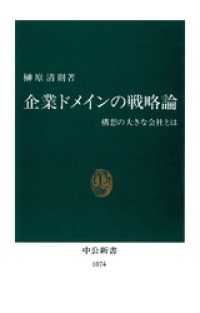- ホーム
- > 洋書
- > ドイツ書
- > Mathematics, Sciences & Technology
- > Technology
- > mechanical engineering & production engineering
Full Description
This book deepens the current understanding of the thermodynamics and kinetics of metallic glass-forming liquids, and their connection with the glass-formation process in terms of fundamental physical metallurgy concepts. It surveys and reports on the progress made in the last few decades to access the ultra-viscous liquid state of thermally stable bulk metallic glass (BMG) forming alloys and study the changes in atomic structure, viscosity, and enthalpy during the vitrification including physical aging.
Featuring a comprehensive look at the physical properties of the undercooled liquid in the ultra-viscous state at temperatures near the glass transition, the book reports on detailed investigations of the thermodynamic functions, viscosity, volume, relaxation time, and structural ordering in the undercooled liquid. Additionally, it introduces state-of-the-art in-situ characterization tools such as chip-calorimetry, synchrotron x-ray diffraction, and x-ray photon correlation spectroscopy as applied to novel studies of liquid-liquid transitions in the supercooled liquid and in the vicinity of the glass transition, and establishes these common, if not universal, phenomena in BMG-forming alloys.
This book is intended for researchers, graduate students, and professionals in the fields of materials science, physical metallurgy, and condensed matter physics, who are interested in the thermodynamics and kinetics of metallic glass-forming liquids and their connection with the glass formation process.
Contents
Introduction.- Part I Survey.- 2 History of metallic glasses.- 2.1 Early metallic glasses.- 2.1.1 Vapour deposited thin films.- 2.1.2 The discovery of metallic glasses.- 2.2 Bulk metallic glasses (BMG).- 2.3 Processing technology development.- 3 Properties and applications of bulk metallic glasses.- 3.1 Properties of bulk metallic glasses.- 3.1.1 Soft magnetic properties.- 3.1.2 Mechanical properties.- 3.1.3 High-temperature oxidation resistance.- 3.1.4 Electrochemical properties and corrosion resistance.- 3.2 Some applications of bulk metallic glasses.- 3.2.1 Soft-magnetic applications.- 3.2.2 Applications as small complex, high strength parts.- 3.2.3 Catalytic applications.- 3.2.4 Jewellery applications.- 3.2.5 Biomedical applications.- Part II Thermophysical properties of BMG-forming liquids.- 4 Thermodynamics of glass-forming liquids.- 4.1 Thermodynamic studies.- 4.1.1 Calorimetric scans at constant heating rates.- 4.1.2 Specific heat capacity measurements.- 4.1.3 Calculation of the thermodynamic functions.- 4.1.4 Driving force for crystallisation.- 4.2 CALPHAD modelling.- 4.3 Metastable phase diagrams.- 5 Thermodynamic and kinetic aspects of the glass transition.- 5.1 Thermodynamic signatures of the glass transition.- 5.2 Studies of the Prinogine-Defay ratio of bulk metallic glasses.- 5.3 Kinetic signatures of the glass transition.- 5.4 Kauzmann temperature and ideal thermal glass transition.- 5.5 Definition of the limiting fictive temperature.- 6 Glass transition studies of bulk metallic glasses.- 6.1 Standard DSC scansfor the study of the glass transition.- 6.2 Vitrification kinetics studies via chip-calorimetry.- 6.3 Dynamic glass transition.- 6.3.1 Temperature modulating calorimetry.- 6.3.2 Multifrequency step-response analysis.- 6.3.3 Cooperative length scale at the glass transition.- 6.3.4 Dynamic glass transition temperature versus fictive temperature.- 6.4 Structural signatures of the glass transition.- 7 Physical aging studies in bulk-metallic glasses.- 7.1 Introduction to physical aging.- 7.2 Viscosity relaxation studies.- 7.3 Volume relaxation studies.- 7.4 Enthalpy relaxation studies.- 7.5 Enthalpy recovery studies.- 7.6 Activation energy spectrum of relaxation.- 7.7 Atomic dynamics via XPCS studies.- 8 Fragility of bulk metallic glass-forming liquids.- 8.1 Kinetic fragility.- 8.2 Thermodynamic fragility.- 8.3 Structural fragility.- 9 Liquid-liquid transition in bulk metallic glass-forming liquids.- 9.1 Kinetic crossovers.- 9.2 Thermodynamic signatures of the liquid-liquid transition.- 9.3 Dynamic crossovers.- 9.4 Shear rate-induced mechanisms.- 10 Glass forming ability of bulk metallic glasses.- 10.1 Empirical rules for glass forming ability.- 10.2 Description of glass forming ability based on TTT-diagrams.- 11 Summarizing remarks.- 11.1 Vitrification kinetics versus atomic mobility.- 11.2 Activation energy spectrum for enthalpy relaxation.- 11.3 Connection between the kinetic fragility, thermodynamics and structural changes in the undercooled liquid.- 11.4 Crossovers during the liquid-liquid transition.- 11.5 Glass forming ability of bulk metallic glasses.








